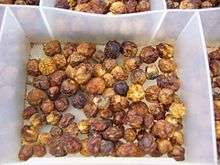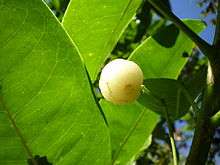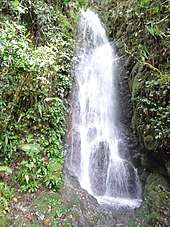Bush tucker
Bush tucker, also called bushfood, is any food native to Australia and used as sustenance by Indigenous Australians, the Aboriginal and Torres Strait Islander peoples, but it can also describe any native fauna or flora used for culinary or medicinal purposes, regardless of the continent or culture. Animal native foods include kangaroo, emu, witchetty grubs and crocodile, and plant foods include fruits such as quandong, kutjera, spices such as lemon myrtle and vegetables such as warrigal greens and various native yams.
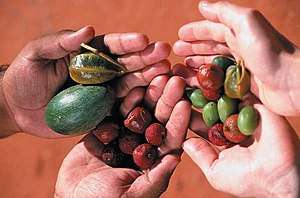
Traditional Indigenous Australians' use of bushfoods has been severely affected by the colonisation of Australia in 1788 and subsequent settlement by non-Indigenous peoples. The introduction of non-native foods, together with the loss of traditional lands, resulting in reduced access to native foods by Aboriginal people, and destruction of native habitat for agriculture, has accentuated the reduction in use.
Since the 1970s, there has been recognition of the nutritional and gourmet value of native foods by non-Indigenous Australians, and the bushfood industry has grown enormously. Kangaroo meat has been available in supermarkets since the 1980s, and a number of other foods is sold in restaurants or packaged as gourmet foods, which has led to expansion of commercial cultivation of native food crops.
History
Aboriginal Australians have eaten native animal and plant foods for an estimated 60,000 years of human habitation on the Australian continent, using various traditional methods of processing and cooking.[1] An estimated 5,000 species of native food were used by Aboriginal peoples. With much of it unsafe or unpalatable raw, a variety of methods were employed to render the various foods edible, such as cooking on open fires (meat) or boiling in bark containers. They would pound some vegetables and seeds, or hang them in bags in running water.[2]
Colonisation
Bush tucker provided a source of nutrition to the non-indigenous colonial settlers, often supplementing meagre rations. However, bushfoods were often considered to be inferior by colonists unfamiliar with the new land's food ingredients, generally preferring familiar foods from their homelands.[3][4][5]
Especially in the more densely colonised areas of south-eastern Australia, the introduction of non-native foods to Aboriginal people resulted in an almost complete abandonment of native foods by them. This impact on traditional foods was further accentuated by the loss of traditional lands, which has resulted in reduced access to native foods by Aboriginal people, and destruction of native habitat for agriculture.[2]
The 19th century English botanist, Joseph Dalton Hooker, writing of Australian plants in Flora of Tasmania, remarked although "eatable," are not "fit to eat". In 1889, botanist Joseph Maiden reiterated this sentiment with the comment on native food plants "nothing to boast of as eatables."[6] The first monograph to be published on the flora of Australia reported the lack of edible plants on the first page, where it presented Billardiera scandens as, "... almost the only wild eatable fruit of the country".[7]
Modern use
Apart from the macadamia nut, with the first small-scale commercial plantation being planted in Australia in the 1880s, no native food plants were produced commercially until the 1990s. The macadamia was the only Australian native plant food developed and cropped on a large scale,[2] but Hawaii was where the macadamia was commercially developed to its greatest extent, from stock imported from Australia.[8]
From the 1970s non-Indigenous Australians began to recognise the previously overlooked native Australian foods. Textbooks such as Wildfoods in Australia (1981) by the botanist couple Alan and Joan Cribb[9] were popular. In the late 1970s horticulturists started to assess native food-plants for commercial use and cultivation.
In 1980 South Australia legalised the sale of kangaroo meat for human consumption,[10] and it is now commonly found in supermarkets and prized for its nutritional value as a lean meat.[2] Analysis shows that a variety of bushfoods are exceptionally nutritious.[10] In the mid-1980s, several Sydney restaurants began using native Australian ingredients in recipes more familiar to non-Indigenous tastes – providing the first opportunity for bushfoods to be tried by non-Indigenous Australians on a serious gourmet level. This led to the realisation that many strongly flavoured native food plants have spice-like qualities.
Following popular TV programs on "bush tucker", a surge in interest in the late 1980s saw the publication of books like Bushfood: Aboriginal Food and Herbal Medicine by Jennifer Isaacs, The Bushfood Handbook and Uniquely Australian by Vic Cherikoff, and Wild Food Plants of Australia by Tim Low.[10]
An advantage of growing the native foods is that they are well adapted to Australia’s environment, in particular at the extreme ends, they are ecologically sound.[2] Bush tucker ingredients were initially harvested from the wild, but cultivated sources have become increasingly important to provide sustainable supplies for a growing market, with some Aboriginal communities also involved in the supply chain. However, despite the industry being founded on Aboriginal knowledge of the plants, Aboriginal participation in the commercial sale of bush tucker is currently still marginal, and mostly at the supply end of value chains. Organisations are working to increase Aboriginal participation in the bush tucker market. Gourmet style processed food and dried food have been developed for the domestic and export markets.
The term "bushfood" is one of several terms describing native Australian food, evolving from the older-style "bush tucker" which was used in the 1970s and 1980s.
In the 21st century, many restaurants are serving emu, crocodile, yabbies and locally-sourced eels, and using native plant spices for flavour. Producers have sprung up across the country to serve the new markets, including Tasmanian pepper, Victorian eel farms and South Australian plantations of quandongs, bush tomatoes, and native citrus.[2]
In 2020, researchers at the University of Queensland were researching a fruit native to Arnhem Land in the Northern Territory, Buchanania obovata, known as the green plum. Eaten for more than 53,000 years but previously little-known among non-Indigenous people, the scientists learnt about the plum from people at the remote community of Yirrkala. It is harvested some time after the Kakadu plum harvests. Nutritional analysis showed high levels of protein, dietary fibre and the minerals potassium, phosphorus and magnesium. In addition, the folate level is among the highest of commercially available fruits. Its potential as a commercial crop for Indigenous communities is being investigated.[11]
Types of foods
Toxic seeds, such as Cycas media and Moreton Bay chestnut, are processed to remove the toxins and render them safe to eat. Many foods are also baked in the hot campfire coals, or baked for several hours in ground ovens. "Paperbark", the bark of Melaleuca species, is widely used for wrapping food placed in ground ovens. Bush bread such as "Johnny cakes" were made by males using many types of seeds, nuts and corns to process a flour or dough. Some animals such as kangaroos, were cooked in their own skin and others such as turtles, were cooked in their own shells.[1]
Kangaroo is quite common and can be found in Australian supermarkets, often cheaper than beef. Other animals, for example emu, goanna and witchetty grubs, are eaten by Aboriginal Australians. Fish and shellfish are culinary features of the Australian coastal communities.
Examples of Australian native plant foods include the fruits quandong, kutjera, muntries, riberry, Davidson's plum, and finger lime. Native spices include lemon myrtle, mountain pepper, and the kakadu plum. Various native yams are valued as food, and a popular leafy vegetable is warrigal greens. Nuts include bunya nut, and, the most identifiable bush tucker plant harvested and sold in large-scale commercial quantities, is the macadamia nut. Knowledge of Aboriginal uses of fungi is meagre, but beefsteak fungus and native "bread" (a fungus also), were certainly eaten.
Native Australian food-plants listed by culinary province and plant part
Australian bush tucker plants can be divided into several distinct and large regional culinary provinces. Some species listed grow across several climatic boundaries.
Top-end
Monsoonal zone of the Northern Territory, Cape York and North-western Australia.
Fruits
| Adansonia gregorii | boab |
| Buchanania arborescens | sparrow's mango |
| Citrus gracilisrry | |
| Ficus racemosa | cluster fig |
| Manilkara kaukii | wongi |
| Melastoma affine | blue tongue |
| Mimusops elengi | tanjong |
| Morinda citrifolia | great morinda |
| Physalis minima | native gooseberry |
| Terminalia ferdinandiana | kakadu plum |
| Syzygium erythrocalyx | Johnstone's River satinash |
| Syzygium fibrosum | fibrous satinash |
| Syzygium suborbiculare | lady apple |
Vegetables
| Dioscorea alata | purple yam |
| Dioscorea bulbifera | round yam |
| Dioscorea transversa | pencil yam, long yam |
| Eleocharis spp. | spikerush |
| Ipomoea aquatica | water spinach |
| Nelumbo nucifera | lotus |
| Nymphaea macrosperma | water lily |
Nuts
| Cycas media | cycad palm seeds (requires detoxification: see Bush bread ) |
| Semecarpus australiensis | Australian cashew |
| Terminalia catappa | sea almond |
Spices
| Eucalyptus staigeriana | lemon ironbark |
| Melaleuca leucadendra | weeping paperbark |
| Melaleuca viridiflora | kitcha-kontoo |
| Ocimum tenuiflorum | native basil |
Outback Australia
Arid and semi-arid zones of the low rainfall interior.
Fruits
| Capparis spp. | native caper, caperbush |
| Capparis mitchelii | wild orange |
| Capparis spinosa subsp. nummularia | wild passionfruit |
| Carissa lanceolata | bush plum, conkerberry |
| Citrus glauca | desert lime |
| Enchylaena tomentosa | ruby saltbush |
| Ficus platypoda | desert fig |
| Marsdenia australis | doubah, bush banana |
| Owenia acidula | emu apple |
| Santalum acuminatum | quandong, desert or sweet quandong |
| Santalum murrayanum | bitter quandong |
| Solanum centrale | akudjura, Australian desert raisin, bush tomato |
| Solanum cleistogarnum | bush tomato |
| Solanum ellipticum | bush tomato |
Vegetables
| Calandrinia balonensis | parakeelya |
| Ipomoea costata | bush potato |
| Vigna lanceolata | pencil yam |
| Lepidium spp. | peppercresses |
| Portulaca intraterranea | large pigweed |
Seeds
| Acacia aneura | mulga |
| Acacia colei | |
| Acacia coriacea | dogwood |
| Acacia holosericea | strap wattle |
| Acacia kempeana | witchetty bush |
| Acacia murrayana | |
| Acacia pycnantha | |
| Acacia retinodes | |
| Acacia tetragonophylla | dead finish seed |
| Acacia victoriae | gundabluey, prickly wattle |
| Brachychiton populneus | kurrajong |
| Panicum decompositum | native millet |
| Portulaca oleracea | pigweed |
| Triodia spp. | commonly known as spinifex |
Spices
| Eucalyptus polybractea | blue-leaved mallee |
Insects in gall
Eastern Australia
Subtropical rainforests of New South Wales to the wet tropics of Northern Queensland.
Fruit
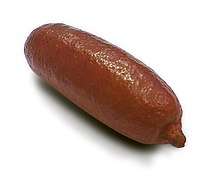
| Acronychia acidula | lemon aspen |
| Acronychia oblongifolia | white aspen |
| Antidesma bunius | Herbet River cherry |
| Archirhodomyrtus beckleri | rose myrtle |
| Austromyrtus dulcis | midyim |
| Carpobrotus glaucescens | pigface |
| Citrus australasica | finger lime |
| Citrus australis | dooja |
| Davidsonia jerseyana | New South Wales Davidson's plum |
| Davidsonia johnsonii | smooth davidsonia |
| Davidsonia pruriens | North Queensland Davidson's plum |
| Diploglottis campbellii | small-leaf tamarind |
| Eupomatia laurina | bolwarra |
| Ficus coronata | sandpaper fig |
| Melodorum leichhardtii | zig zag vine |
| Pandanus tectorius | Hala fruit |
| Pleiogynium timoriense | Burdekin plum |
| Podocarpus elatus | Illawarra plum |
| Planchonella australis | black apple |
| Rubus moluccanus | broad-leaf bramble |
| Rubus probus | Atherton raspberry |
| Rubus rosifolius | rose-leaf bramble |
| Syzygium australe | brush cherry |
| Syzygium luehmannii | riberry |
| Syzygium paniculatum | magenta lilly pilly |
| Ximenia americana | yellow plum |
Vegetable
| Apium prostratum | sea celery |
| Commelina cyanea | scurvy weed |
| Geitonoplesium cymosum | scrambling lily |
| Tetragonia tetragonoides | warrigal greens |
| Trachymene incisa | wild parsnip |
| Urtica incisa | scrub nettle |
Spices
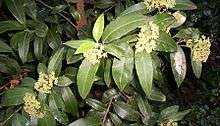
| Alpinia caerulea | native ginger |
| Backhousia citriodora | lemon myrtle |
| Backhousia myrtifolia | cinnamon myrtle |
| Backhousia anisata | aniseed myrtle |
| Leptospermum liversidgei | lemon tea-tree |
| Prostanthera incisa | cut-leaf mintbush |
| Smilax glyciphylla | sweet sarsaparilla |
| Syzygium anisatum | aniseed myrtle |
| Tasmannia stipitata | Dorrigo pepper (leaf and pepperberry) |
Nut
| Araucaria bidwillii | bunya nut |
| Athertonia diversifolia | Atherton almond |
| Macadamia integrifolia | macadamia nut |
| Macadamia tetraphylla | bush nut |
| Sterculia quadrifida | peanut tree |
Temperate Australia
Warm and cool temperate zones of southern Australia, including Tasmania, South Australia, Victoria and the highlands of New South Wales.
Tasmania
| Scientific name | Common name | Edible part of plant | Use | Details | Citation |
|---|---|---|---|---|---|
| Acacia mearnsii | Black Wattle | Bark | Tea | Bark can be soaked to make a tea, which is claimed to be good for indigestion. | [12] |
| Kennedia prostrata | Running Postman | Flower | Garnish | The nectar from the flowers is edible. | [12] |
| Lomandra longifolia | Sagg | Flower | Garnish | Young leaves, flowers and seeds are ideal | [12] |
| Wahlenbergia multicaulis | Bushy Bluebell | Flower | Garnish | [12] | |
| Wahlenbergia stricta | Flower | Garnish | [12] | ||
| Xanthorrhea australis | Grass Tree | Flower | Garnish | The nectar from the flowers is edible. | [12] |
| Viola hederacea | Wild Violet | Flower | Salad | The flowers are edible and can be used in salads. | [12] |
| Astroloma humisifusum | Native Cranberry | Fruit | Fruit | The berries can be consumed, when ripe. | [12] |
| Astroloma pinifolium | Pine Heath | Fruit | Fruit | The berries can be consumed, when ripe. | [12] |
| Billardiera longiflora | Mountain Blue Berry | Fruit | Fruit | Edible fruit when ripe | [12] |
| Billardiera scandens | Apple Dumplings | Fruit | Fruit | The berries can be consumed, when ripe. | [12] |
| Coprosma nitida | Mountain Currant | Fruit | Fruit | The berries can be consumed, when ripe. | [12] |
| Coprosma quadrifida | Native Currant | Fruit | Fruit | Edible berries - raw or stewed | [12] |
| Dianella brevicaulis | Shortstem Flaxlily | Fruit | Fruit | The berries can be consumed, when ripe. | [12] |
| Dianella revoluta | Spreading Flaxlily | Fruit | Fruit | The berries can be consumed, when ripe. | [12] |
| Dianella tasmanica | Blue Flax Lily | Fruit | Fruit | The berries can be consumed, when ripe. | [12] |
| Einardia nutans | Climbing Saltbush | Fruit | Fruit | The fruit can be consumed, when ripe. | [12] |
| Solanum laciniatum | Kangaroo Apple | Fruit | Fruit | Only the very ripe fruit is edible....Note: the green fruit is POISONOUS. | [12] |
| Tasmannia lanceolata | Native Pepper | Fruit | Fruit | If the berries are dried, they can be consumed. | [12] |
| Acmena smithii | Lilly Pilly | Fruit | Jam/compote | Berries can either be eaten raw or made into a jam or compote. | [12] |
| Carprobrotus rossii | Native Pigface | Fruit | Jam/compote | The ripe fruit eaten raw or made into a compote. | [12] |
| Acacia mearnsii | Black Wattle | Gum | Condiment | [12] | |
| Eucalyptus gunnii | Cider Gum | Gum | Condiment | The gum is sweet and edible. | [12] |
| Lomandra longifolia | Sagg | Leaf/shoot | Salad | Consume the young leaves | [12] |
| Phragmites australis | Common Reed | Leaf/shoot | Salad | [12] | |
| Suaeda australis | Seablite | Leaf/shoot | Salad | [12] | |
| Tasmannia lanceolata | Native Pepper | Leaf/shoot | Salad | Dry the leaves before consumption. | [12] |
| Xanthorrhea australis | Grass Tree | Leaf/shoot | Salad | The young leaves can be consumed. | [12] |
| Ozothamnus obcordatus | Native Thyme | Leaf/shoot | Seasoning | When the leaves are dried, their taste resembled that of thyme. It can be used as a seasoning. | [12] |
| Correa alba | White Correa | Leaf/shoot | Tea | The leave may be used to prepare a tea. | [12] |
| Hardenbergia violacea | Sarsparilla Vine | Leaf/shoot | Tea | In order to make a tea, the leaves need to be initially boiled, then dried. | [12] |
| Kunzea ambigua | White Kunzea | Leaf/shoot | Tea | A refreshing tea can be made from the dried leaves. | [12] |
| Atriplex cinerea | Grey Saltbush | Leaf/shoot | Vegetable | In order to remove some of the salt from the leaves, the leaves need to be thoroughly soaked in water. After rinsing, the leaves can be used as a type of vegetable / salad. | [12] |
| Tetragonia implexicoma | Bower Spinach | Leaf/shoot | Vegetable | The leaves are edible in both a raw or cooked state. | [12] |
| Triglochin procera | Water Ribbons | Leaf/shoot | Vegetable | The leaves are edible in both a raw or cooked state. | [12] |
| Typha domingensis | Bulrush | Leaf/shoot | Salad | Consume the young shoots from the plant. | [12] |
| Typha orientalis | Broad-leafed Bulrush | Leaf/shoot | Salad | Consume the young shoots from the plant. | [12] |
| Arthropodium milleflorum | Vanilla Lily | Root/tuber/bulb | Vegetable | The tubers can be consumed in both a raw or roasted state. | [12] |
| Arthropodium strictum | Chocolate Lily | Root/tuber/bulb | Vegetable | The tubers can be consumed in both a raw or roasted state. NOTE: the chocolate scented flowers are NOT edible, however. | [12] |
| Bolboschoenus caldwellii | Sea Clubsedge | Root/tuber/bulb | Vegetable | The roots are edible once they've been roasted. | [12] |
| Bulbine bulbosa | Golden Rock Lily | Root/tuber/bulb | Vegetable | The bulb of the plant can be consumed after it has been roasted. It is particularly nutritious. | [12] |
| Burchardia umbellata | Milk Maids | Root/tuber/bulb | Vegetable | The tuber of the plant can be consumed once it has been roasted. | [12] |
| Clematis aristata | Travellers Joy | Root/tuber/bulb | Vegetable | Once the taproot has been roasted, it is edible. | [12] |
| Clematis microphylla | Small Leaf Clematis | Root/tuber/bulb | Vegetable | Once the taproot has been roasted, it is edible. | [12] |
| Convolvulus angustissimus | Pink Moonflower | Root/tuber/bulb | Vegetable | Once the taproot has been roasted, it is edible. | [12] |
| Eleocharis sphacelata | Tall Rush Spike | Root/tuber/bulb | Vegetable | The roots are edible | [12] |
| Geranium solanderi | Southern cranesbill | Root/tuber/bulb | Vegetable | Once the taproot has been roasted, it is edible. | [12] |
| Microseris lanceolata | Yam Daisy, Murnong | Root/tuber/bulb | Vegetable | The tubers can be consumed in both a raw or roasted state. | [12] |
| Phragmites australis | Common Reed | Root/tuber/bulb | Vegetable | [12] | |
| Xanthorrhea australis | Grass Tree | Root/tuber/bulb | Vegetable | The young roots are edible | [12] |
| Typha domingensis | Bulrush | Root/tuber/bulb | Vegetable | [12] | |
| Typha orientalis | Broad-leafed Bulrush | Root/tuber/bulb | Vegetable | [12] | |
| Dodonaea viscosa | Native Hop | Seed | Alcohol | Seeds can be used instead of hops to brew beer | [12] |
| Acacia melanoxylon | Blackwood | Seed | Nuts | [12] | |
| Acacia retinodes | Wirilda | Seed | Nuts | Both the seeds and green pods can be consumed. | [12] |
| Acacia sophorae | Boobyalla/Coast Wattle | Seed | Nuts | The seeds can be consumed in both the raw or roasted state. | [12] |
| Brachychiton populneus | Kurrajong (Tas prov) | Seed | Nuts | The seeds of this plant are particularly nutritious. The seeds can be consumed in both the raw or roasted state. | [12] |
| Lomandra longifolia | Sagg | Seed | Nuts | [12] | |
| Phragmites australis | Common Reed | Seed | Nuts | [12] | |
| Acacia mearnsii | Black Wattle | Seed | Nuts | [12] | |
| Sarcoconia quinqueflora | Samphire or Glasswort | Stem | Fibre | Consumption of the younger stems of the plant is suggested | [12] |
| Phragmites australis | Common Reed | Stem | Fibre | [12] |
Fruit
| Acrotriche depressa | native currant |
| Billardiera cymosa | sweet apple-berry |
| Billardiera longiflora | purple apple-berry |
| Billardiera scandens | common apple-berry |
| Carpobrotus rossii | karkalla[13] |
| Exocarpus cupressiformis | native cherry |
| Gaultheria hispida | snow berry |
| Kunzea pomifera | muntries |
| Rubus parvifolius | pink-flowered native raspberry |
| Sambucus gaudichaudiana | white elderberry |
| Enchylaena tomentosa | ruby saltbush[14] |
Seed
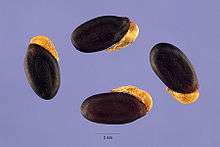
| Acacia longifolia | golden rods |
| Acacia sophorae | coast wattle (All Acacia seeds can be ground into a bush flour.) |
Spice
| Eucalyptus dives | peppermint gum |
| Eucalyptus olida | strawberry gum |
| Eucalyptus globulus | tasmanian blue gum |
| Mentha australis | river mint |
| Prostanthera rotundifolia | native thyme |
| Tasmannia lanceolata | mountain pepper |
| Tasmannia stipitata | Dorrigo pepper |
Vegetable
| Apium insulare | Flinders Island celery |
| Atriplex cinerea | grey saltbush |
| Burchardia umbellata | milkmaids |
| Eustrephus latifolius | wombat berry |
| Microseris lanceolata | murnong |
In the media
TV shows made use of the bush tucker theme. Malcolm Douglas was one of the first presenters to show how to 'live off the land' in the Australian Outback. Major Les Hiddins, a retired Australian Army soldier popularised the idea of bush tucker as an interesting food resource. He presented a hit TV series called The Bush Tucker Man on the ABC TV network in the late 1980s. In the series, Hiddins demonstrated his research for NORFORCE in identifying foods which might sustain or augment army forces in the northern Australian Outback. 'NORFORCE' is a Regional Force Surveillance Unit of the Australian Army Reserve.
In early 2003, the first cooking show featuring authentic Australian foods and called Dining Downunder was produced by Vic Cherikoff and Bailey Park Productions of Toronto, Canada. This was followed by the Special Broadcasting Service (SBS) production of Message Stick with Aboriginal chef, Mark Olive.
In 2008 Ray Mears recently made a survival television series called Ray Mears Goes Walkabout, which focused on the history of survival in Australia, with a focus on bush tucker. In the series, Les Hiddins was a guest in one episode, with the two men sharing their knowledge and discussing various aspects of bush tucker.
In the TV survival series Survivorman, host and narrator Les Stroud spent time in the Australian outback. After successfully finding and eating a witchetty grub raw he found many more and cooked them, stating they were much better cooked. After cooking in hot embers of his fire, he removed the head and the hind of the grub and squeezed out thick yellow liquid before eating.
The SBS documentary series Food Safari featured bush tucker in an episode that went to air in 2013.[2][18]
See also
- Australian Aboriginal sweet foods
- Australian cuisine
- Bush bread
- Bushfood industry history
- Bushmeat
- Bush medicine
- Damper
- Indigenous Australian food groups
- Country food, equivalent term in Canada used to refer to food eaten by the Indigenous peoples of Canada
References
Footnotes
- Hiddins, Les (2003). Bush Tucker Field Guide. Australia: Explore Australia Publishing. pp. x. ISBN 1741170281.
- "About Native Australian food". Food. 1 July 2008. Retrieved 1 June 2020.
- Newton, John (2016). The Oldest Foods on Earth. Sydney, Australia: NewSouth Publishing. ISBN 9781742234373.
- O'Brien, Charmaine (2016). The Colonial Kitchen. USA: Rowman & Littlefield. ISBN 9781442249813.
- Newling, Jacqui (2015). Eat Your History, Stories and Recipes from Australian Kitchens. Sydney, Australia: Sydney Living Museums and NewSouth Publishing. ISBN 9781742234687.
- Maiden, J.H., The Useful Native Plants of Australia, 1889, p.1
- Smith, J E (1793). Spec. Bot. New Holland. James Sowerby.
AMID all the beauty and variety which the vegetable productions of New Holland display in such profusion, there has not yet been discovered a proportionable degree of usefulness to mankind, at least with respect to food.
- Shigeura, Gordon T.; Ooka, Hiroshi (April 1984). Macadamia nuts in Hawaii: History and production (PDF). Research extension series. University of Hawaii. College of Tropical Agriculture and Human Resources. ISSN 0271-9916. Retrieved 1 June 2020.
- Cribb, A. B. (Alan Bridson); Cribb, J. W. (Joan Winifred), 1930- (1981), Wild medicine in Australia, Fontana/Collins, ISBN 978-0-00-636559-4CS1 maint: multiple names: authors list (link)
- Low, T., Wild Food Plants of Australia, Angus & Robertson, 1992, pp 199–202 ISBN 0-207-16930-6
- Baczkowski, Halina (31 May 2020). "Native green plums from Arnhem Land found to have significant health benefits, commercial appeal". ABC News (Australian Broadcasting Corporation). Landline. Retrieved 1 June 2020. On iview
- "Bush Foods". Wildseed Tasmania. Retrieved 1 June 2020.
- "Edible Pigface Australian - Sustainable Gardening Australia". Sustainable Gardening Australia.
- "Enchylaena tomentosa - Ruby Saltbush - Nurseries Online". 10 July 2016.
- "Neptune's necklace - Seaweed (Hormosira banksii)".
- "Coastal Sword Sedge" (PDF). sercul.org.au. Archived from the original (PDF) on 26 March 2017. Retrieved 24 October 2018.
- "Coast Sword-sedge | Lepidosperma gladiatum". scnaturesearch.com.au. Retrieved 24 October 2018.
- "Food Safari – A Look At Bush Tucker". SBS Food. 4 March 2013. Retrieved 1 June 2020.
Sources
- Bruneteau, Jean-Paul, Tukka, Real Australian Food, ISBN 0-207-18966-8.
- Cherikoff, Vic, The Bushfood Handbook, ISBN 0-646-15496-6.
- Isaacs, Jennifer, Bushfood, Weldons, Sydney.
- Kersh, Jennice and Raymond, Edna's Table, ISBN 0-7336-0539-7.
- Low, Tim, Wild Food Plants of Australia, ISBN 978-0-207-14383-0
Further reading
- "Australian Bushfoods". 31 May 2020. (Supersedes Australian Bushfoods magazine site)
- Clarke, Michael (August 2012). Australian Native Food Industry Stocktake (PDF). Australian Native Foods Industry Stocktake, Publication No. 12/066, Project No. PRJ-005855. Australian Government. Rural Industries Research and Development Corporation. ISBN 978-1-74254-409-0. ISSN 1440-6845.
- Clarke, Philip (2007). Aboriginal People and Their Plants. Long abstract; full text available on request.
- "CSIRO CSE Research". Australian Native Foods. 27 August 2007.
- "Indigenous Weather Knowledge: Walabunnba - Wantangka - hot weather". Bureau of Meteorology. Bush Bean (Wakalpirri) and Bush Plum.
- Miers, Geoff (July 2004). Cultivation and sustainable wild harvest of Bushfoods by Aboriginal Communities in Central Australia: A report for the Rural Industries Research and Development Corporation (PDF). RIRDC Web-only Publication No W03/124, RIRDC Project No CLC-1A. Australian Government. Rural Industries Research and Development Corporation. ISBN 0 642 58690 X. ISSN 1440-6845.
.jpg)
